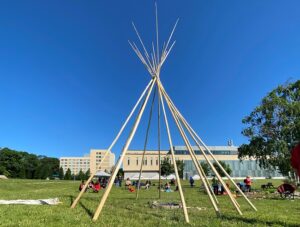Lakehead University celebrates National Indigenous Peoples Day

By Rick Garrick
ORILLIA — A Sunrise Ceremony, flint knapping, wampum belt, teepee, and drum teachings and a truth and reconciliation dialogue were featured at Lakehead University’s June 18 Tipi Raising Gathering at the Orillia campus. The Sunrise Ceremony was led by Beausoleil Elder Trish Monague, the flint knapping by M’Chigeeng First Nation’s Shawn Corbiere, the wampum belt by Chippewas of Georgina Island’s Brian Charles, the teepee and drum teachings and teepee raising by Moose Cree Elder Jimmy Dick, and the truth and reconciliation dialogue by Chippewas of Georgina Island’s Cynthia Wesley-Esquimaux.
“We had a great turnout — it was a big learning experience for some of the folks,” says Corbiere, flint knapping Knowledge Keeper and Indigenous liaison officer at Georgian Bay Islands National Park/Beausoleil Island National Historic Site who was a consultant for the movie, The Silencing, which was filmed in Sudbury. “We have an archaeological site that dates back over 5,000 years [at] Georgian Bay Islands National Park. We know that stone tool manufacturing was going over 5,000 years ago over there on the island, so I wanted to bring that knowledge back home because it’s a dying art.”
Corbiere says he shared his knowledge about arrow heads during the gathering, noting that many arrowheads in museums and cultural centres were used on atlatls, or Apaginaatig Ataadiiwin in Anishinaabemowin, a spear-throwing lever used to throw arrows at prey.
“I can make the arrowheads that fit on these great big arrows that would have been thrown at woolly mammoths and mastodons and woodland caribou,” Corbiere says. “I do the shafts and I do the traditional wrap and I do a traditional Cherokee feather style of fletching. It looks like I have four feathers on it but I only used two. I also use pine pitch to weather [waterproof and protect from the sun] the sinew, or animal gut.”
Wesley-Esquimaux, chair of truth and reconciliation at Lakehead University, says she has been noticing a separate internal reconciliation process among First Nations people over the past several years.
“I notice very much that First Nations communities, with all of this truth telling and all this conversation with the government around where do we go from here and resolution of outstanding grievances, that people are actually looking inside now very closely and are doing sort of an internal reconciliation process amongst Indigenous peoples themselves, and I think that’s really strengthening language and culture and ceremony,” Wesley-Esquimaux says. “I think the younger generation is really contributing to that, so they’re not so interested in the larger Canadian reconciliation process but they’re very interested in the process that’s happening within their own territory.”
Wesley-Esquimaux adds that for the external reconciliation process, she is telling people that it is very important for Canadians to accept the question of vulnerability and humility in their process.
“They are not going to understand where Indigenous people are coming from until they understand their own need to create or understand or feel or live the vulnerability that the First Nations communities, Inuit, and Métis people have also already experienced,” Wesley-Esquimaux says.
Wesley-Esquimaux also stressed that reconciliation is based on early treaties of peace and friendship such as the Dish with One Spoon wampum agreement between the Haudenosaunee and Anishinabek.
“And the restoration process is about restoring peace and friendship, but it won’t happen if the historic grievances are not also resolved at the same time,” Wesley-Esquimaux says.
Mercedes Jacko, Indigenous Initiatives coordinator at Lakehead University Orillia Campus, says the Tipi Raising Gathering was held prior to National Indigenous Peoples Day to allow people to celebrate National Indigenous Peoples Day in their own or local communities.


